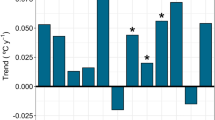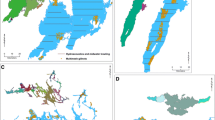Abstract
We used multiple linear regression analysis to investigate relationships between late-summer epilimnion thickness, transparency, lake area, acidity and summer weather conditions in a large ($n = 116$) multi-year data set for 9 small Boreal Shield lakes. Dissolved organic carbon (DOC) was the best individual predictor of late summer epilimnion thickness ($r^{2} = 0.69$). Total chlorophyll~$a$, the number of days between ice-out and late-summer stratification, and lake area collectively explained an additional 14% of the variation in epilimnion thickness. The three attributes of summer weather that we examined, mean daily temperature, mean daily wind speed, and mean daily hours of bright sunshine, did not add to the predictive ability of our regression model. Lake acidity also did not add directly to the predictive ability of the model, likely because DOC concentrations already reflected the effects of pH. Our study supports an increasing body of evidence indicating that the dominant effects of climate change on lake thermal structure in small lakes will be through effects on processes that affect lake transparency.
Similar content being viewed by others
References
Dillon, P. J., Clark, B. J., Molot, L. A. and Evans, H. E.: 2003, ‘Predicting the location of optimal habitat boundaries for lake trout (Salvelinus namaycush) in Canadian Shield lakes’, Can. J. Fish. Aquat. Sci. 60, 959–970.
Dixit, S., Keller, W., Dixit, A. and Smol, J. : 2001, ‘Diatom-inferred dissolved organic carbon reconstructions provide assessments of past UV-B penetration in Canadian Shield lakes’, Can. J. Fish. Aquat. Sci. 58, 543–550.
Environment Canada: 1998, ‘Adapting to Climate Variability and Change in Ontario’, Volume IV of the Canada Country Study: Climate Impacts and Adaptation, ISBN 0-662-25922-X, 117 pp.
Fee, E. J., Hecky, R. E., Kasian, S. E. M. and Cruikshank, D. R.: 1996, ‘Effects of lake size, water clarity, and climatic variability on mixing depths in Canadian Shield lakes’, Limnol. Oceanogr. 41, 912–920.
Gennings, C., Molot, L. A. and Dillon, P. J.: 2001, ‘Enhanced photochemical loss of organic carbon in acidic waters’, Biogeochemistry 52, 339–354.
Keller, W., Dillon, P. J., Heneberry, J., Malette, M. and Gunn, J.: 2001, ‘Sulphate in Sudbury, Ontario, Canada lakes: Recent trends and status’, Water Air Soil Pollut. 130, 793–798.
Keller, W., Heneberry, J. H. and Dixit, S. S.: 2003, ‘Decreased acid deposition and the chemical recovery of Killarney, Ontario, lakes’, Ambio 32, 183–189.
Keller, W., Heneberry, J. H. and Leduc, J.: 2005, ‘Linkages between weather, dissolved organic carbon and coldwater habitat in a Boreal Shield lake recovering from acidification’, Can. J. Fish. Aquat. Sci. 62, 340–346.
Magnuson, J. J., Robertson, D. M., Benson, B. J., Wynne, R. H., Livingstone, D. M., Arai, T., Assel, R. A., Barry, R. G., Card, V., Kuusisto, E., Granin, N. G., Prowse, T. D., Stewart, K. M. and Vuglinski, V. S.: 2000, ‘Historical trends in lake and river ice cover in the Northern Hemisphere’, Science 289, 1743–1746.
Molot, L. A. and Dillon, P. J.: 1997, ‘Colour – mass balances and colour – dissolved organic carbon relationships in lakes and streams in central Ontario’, Can. J. Fish. Aquat. Sci. 54, 2789–2795.
Patrick, K. L.: 2003, ‘Timing of Lake Stratification and Ice Cover in Small Northern Ontario Lakes’, M.Sc. Thesis, Laurentian University, Sudbury, Ontario, Canada, 98 pp.
Patrick, K. L., Gunn, J. M. and Futter, M.: ‘Modelling the duration of ice cover, timing of spring stratification and end of season thermal structure in small Precambrian Shield lakes’, Can. J. Fish. Aquat. Sci. (in press).
Pérez-Fuentetaja, A., Dillon, P. J., Yan, N. D. and McQueen, D. J.: 1999, ‘Significance of dissolved organic carbon in the prediction of thermocline depth in small Canadian shield lakes’, Aquatic Ecol. 33, 127–133.
Robertson, D. M. and Ragotzkie, R. A.: 1990, ‘Changes in the thermal structure of moderate to large sized lakes in response to changes in air temperature’, Aquatic Sci. 52, 360–380.
Schindler, D. W., Beaty, K. G., Fee, E. J., Cruikshank, D. R., DeBruyn, E. R., Findlay, D. L., Linsey, G. A., Shearer, J. A., Stainton, M. P. and Turner, M. A.: 1990, ‘Effects of climatic warming on lakes of the central Boreal forest’, Science 250, 967–970.
Schindler, D. W., Curtis, P. J., Parker, B. R. and Stainton, M. P.: 1996, ‘Consequences of climate warming and lake acidification for UV-B penetration in North American boreal lakes’, Nature 379, 705–708.
Schindler, D. W.: 2001, ‘The cumulative effects of climate warming and other human stresses on Canadian freshwaters in the new millenium’, Can. J. Fish. Aquat. Sci. 58, 18–29.
Snucins, E. and Gunn, J. M.: 2000, ‘Interannual variation in the thermal structure of clear and colored lakes’, Limnol. Oceanogr. 45, 1639–1646.
Snucins, E. J., Gunn, J. M. and Keller, W.: 1995, ‘Preservation of Biodiversity: Aurora Trout’, in: J. M. Gunn (ed), Restoration and Recovery of an Industrial Region, Springer Verlag, New York, pp.143–153.
Wetzel, R. G.: 1975, Limnology, W. B. Saunders, Philadelphia, 743 pp.
Yan, N. D., Keller, W. and Gunn, J. M.: 1995, ‘Liming of Sudbury Lakes: Lessons for Recovery of Aquatic Biota from Acidification’, in: J. M. Gunn (ed), Restoration and Recovery of an Industrial Region, Springer Verlag, New York, pp.195–204.
Yan, N. D., Keller, W., Scully, N. M., Lean, D. R. S. and Dillon, P. J.: 1996, ‘Increased UV-B penetration in a lake owing to drought-induced acidification’, Nature 381, 141–143.
Author information
Authors and Affiliations
Corresponding author
Rights and permissions
About this article
Cite this article
Keller, W.B., Heneberry, J., Leduc, J. et al. Variations in Epilimnion Thickness in Small Boreal Shield Lakes: Relationships with Transparency, Weather and Acidification. Environ Monit Assess 115, 419–431 (2006). https://doi.org/10.1007/s10661-006-7237-x
Received:
Accepted:
Published:
Issue Date:
DOI: https://doi.org/10.1007/s10661-006-7237-x




